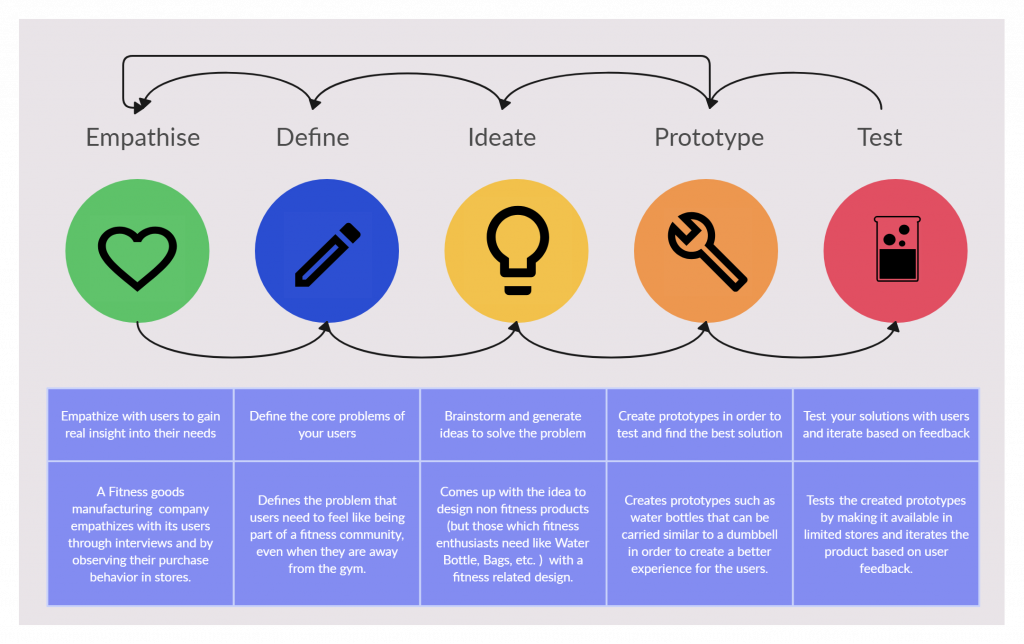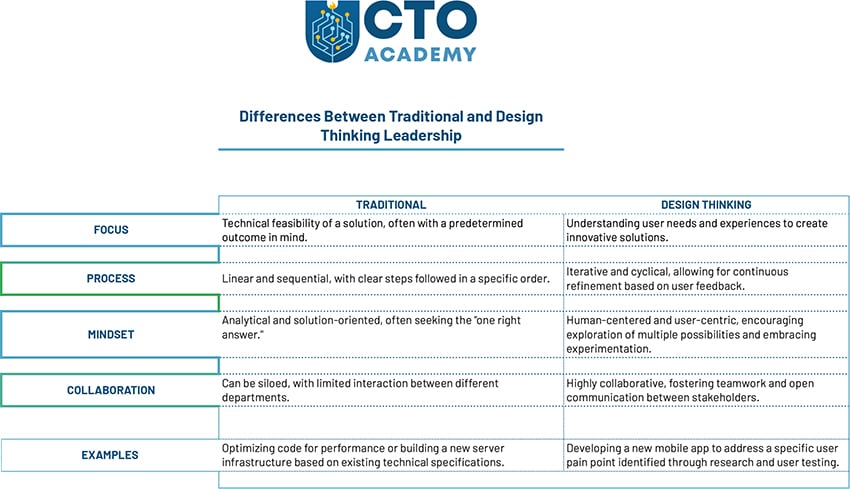Constantly evolving user needs and expectations are challenging traditional leadership styles. That’s why technology leaders are switching to a design thinking model which is, basically, a human-centred approach to problem-solving.
Design thinking focuses on understanding user needs and experiences to create innovative solutions. Such products and services resonate with their target audience.
This article explores the critical role design thinking plays in modern technology leadership.
Remember, just because you’re utilising Agile methodologies, doesn’t necessarily imply that you’re a design-thinking leader. You’ll see why shortly.
The speed of technological advancements and ever-shifting user demands expose traditional models’ limitations. Key problems are:
Old school leaders often prioritise the technical feasibility of a solution over understanding the user’s needs and pain points. This approach can lead to overly complex and unintuitive products or miss the mark altogether.
Traditional structures can also create silos between departments like engineering and design. Such solutions lack a holistic perspective due to collaboration breakdown.
Silo thinking and focus on tech over the actual users’ needs means that the team is most likely risk-averse and prioritising proven solutions. It is the definition of a culture that stifles the level of creative exploration needed to drive breakthrough innovations.
Add lengthy research and analysis to this mixture and you end up with sluggish decision-making and missed opportunities.
Design thinking helps you navigate all these challenges and removes limitations. By prioritising user needs, fostering collaboration and embracing rapid iteration, design thinking gives you five distinct advantages.
Since you’re flipping the script by fostering empathy and user research, you develop solutions that address user pain points. This leads to products and services that gain traction and win in the market.
Imagine a CTO leading the development of a new mobile app. Through design thinking, they can ensure the app solves a real user problem and not just act as a cool tech.
As a design-thinking tech leader, you are encouraging experimentation while, at the same time, breaking down silos between departments. This fosters a more creative environment where engineers, designers and other stakeholders can collaborate to generate innovative solutions to complex problems.
Design thinking allows you to tap into the collective intelligence of your team and explore a wider range of possibilities when facing a demanding technical challenge.
Decisions are based on user feedback (data-driven decision-making). The emphasis is, therefore, on prototyping and user testing throughout the development process.
This, in turn, allows you to gather real-time user feedback and refine your solution based on data, not just assumptions.
Such an approach mitigates the risk and helps CTOs make more informed decisions about product direction and resource allocation.
Dedicated workshops and collaborative prototyping sessions break down communication barriers between teams and departments. This fosters a more cohesive work environment where everyone is aligned on the user’s needs and vision.
What makes this possible is your improved ability to effectively communicate your vision to your team and ensure everyone is working towards a common goal.
But how exactly does design-thinking leadership break down silos and foster a more collaborative work environment?
As we said, design thinking places the user at the centre stage. This creates a common ground for teams with traditionally different priorities (e.g., engineers vs. designers) to come together and work towards a shared goal: developing solutions that address user pain points. To put it bluntly, everyone is focused on the same “why” behind the project, fostering a sense of unity and collaboration.
The process itself is inherently collaborative. Workshops, user research activities and prototyping sessions necessitate teams from different departments (engineering, design, marketing…) to work together. This breakdown of departmental barriers enables better communication, knowledge sharing and a more holistic understanding of the problem.
Since the emphasis is on open communication and active listening, there are no more communication silos. Subsequently, the environment encourages a more open exchange of ideas.
However, for the process to work more or less flawlessly, team members from different backgrounds must learn to effectively communicate their perspectives while fostering empathy and understanding for each other’s roles. Hence, the workshops and leading by example!
The iterative nature of design thinking means everyone contributes to the refinement of the solution. This creates a sense of shared ownership and accountability. Subsequently, the teams are increasingly motivated to work together towards a successful outcome.
The important thing to remember here is that recognition for the final solution is not limited to a single department because shared recognition further strengthens collaboration.
This leads us to the critical role of empathy and understanding.
Design thinking heavily relies on user research techniques like interviews and observations. By participating in these activities, engineers, marketers and other stakeholders gain a deeper understanding of the user’s perspective. This shared empathy breaks down departmental divides and builds a stronger sense of teamwork.
Some might argue that such an approach may easily eliminate departmental structures. The reality, however, is that it simply utilises them more effectively. A shared focus on user needs acts as a bridge between departments, cultivating a more collaborative work environment.
This is one of the top priorities of every company and the reason why they need technology leaders (regardless of the industry). But it comes with, sometimes, overwhelming expectations – the boards simply expect their CTOs to provide them with that competitive advantage.
An ace in your sleeve these days is user-centricity. It enables you to develop products and services that resonate with users, leading to increased customer satisfaction, loyalty and, ultimately, a competitive edge.
In its early days, Airbnb struggled to attract users. So they conducted user research and discovered that potential hosts were hesitant due to concerns about security and trust. This led to the development of features like verified profiles, reviews and secure payment systems, ultimately transforming Airbnb into the hospitality giant it is today.
Another successful example is Intuit.
Now, as we all know, tax preparation software can be notoriously complex. Intuit used design thinking to revamp their flagship product, TurboTax. They simply placed focus on user needs and frustrations. The result was a simplified interface, step-by-step guidance and incorporated helpful educational resources. The outcome was a more user-friendly experience and a surge in customer satisfaction.
A similar approach was utilised by Nest Labs. Using design thinking, Nest focused on understanding user behaviour patterns related to energy consumption. After extensive research and analyses, they created a visually appealing and intuitive thermostat that learns user preferences and automatically adjusts temperature settings. This enabled homeowners to enjoy a more comfortable home environment with increased energy efficiency.
But what to do if you want to expand your taxi services to food delivery? Do you lean on traditional leadership models or do you utilise some hard-core design thinking like Uber Eats did a few years back?
“We constantly immerse ourselves in the places where our customers live, work, and eat”, says Paul Clayton Smith from Uber Eats’ design team. “Sitting in our offices in San Francisco or New York, we can’t truly understand the experiences of a person on the streets of Bangkok or London. We need to go there, move about the city, experience the food culture and watch how people use the things we’ve designed”.
Uber Eats has implemented a series of protocols and practices like The Walkabout Program, Order shadowing, and Fireside chats to truly understand the pain points of their market. And, according to Paul, they iterate a lot, “Our business is a marketplace that needs to quickly reach critical mass to provide value to each of our different customers…Swift iteration allows us to move fast and ensure we get the design just right”.
This immersion, iteration and rapid innovation is what powers the Uber Eats design team. It is a design-thinking approach that allows them to solve complex logistical challenges with new technology that resonates with their customers.
Now that we have successfully elaborated on the advantages, let’s dig deeper into our subject.
Design thinking is a human-centred problem-solving methodology that emphasises empathy, user-centricity, iteration and prototyping. It’s a cyclical, non-linear process that allows us to deeply understand user needs, challenge assumptions and ultimately create innovative solutions.
There are four core principles:
There are, typically, five key stages (due to the iterative nature of design thinking, these stages can sometimes overlap or be revisited):


1. Build a Design Thinking Culture
2. Create a Collaborative Space
3. Promote Experimentation and Iteration
4. Integrate Design Thinking into Existing Processes
The takeaway is simple: a tech leader who embraces a culture of design thinking, quickly positions as the one who drives innovation and delivers solutions that create competitive advantage.
Design thinking equips CTOs with a deep understanding of user needs. By prioritising user-centricity throughout the development process, CTOs deliver solutions that resonate with their target audience. This translates to:
Hence, the advice: start exploring design thinking resources, participate in workshops and begin integrating its principles into your approach. Become a future leader who shapes the tech landscape.
Articles:
Harvard Business Review: Look for articles on design thinking in business and technology leadership.
Fast Company: Articles on design thinking for innovation and creative problem-solving.
IDEO Blog: IDEO is a renowned design thinking firm. Their blog features insightful articles on applying design thinking to various industries, including technology.
Books:
“Change by Design: How Design Thinking Transforms Business and Society” by Tim Brown: This book, written by the CEO of IDEO, provides a comprehensive overview of design thinking principles and their application in various contexts.
“Sprint: Solving Big Problems and Testing New Ideas in Just Five Days” by Jake Knapp: This book offers a practical guide to using design thinking sprints, a time-boxed approach to rapidly iterating on ideas and solutions.
“Inspired: How to Create Tech Products Customers Love” by Marty Cagan: While this book focuses on product management, it incorporates design thinking principles and offers valuable insights for CTOs looking to develop user-centric technology solutions.
Remember, this is just a starting point. As you delve deeper into design thinking, you’ll discover a wealth of resources available online and through professional development opportunities.
90 Things You Need To Know To Become an Effective CTO

London
2nd Floor, 20 St Thomas St, SE1 9RS
Copyright © 2024 - CTO Academy Ltd